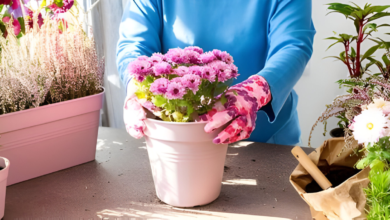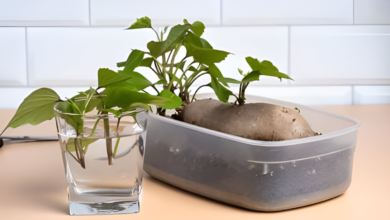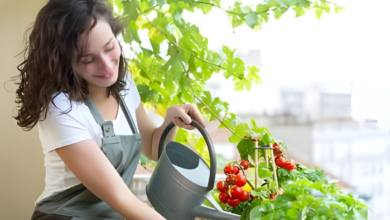Easy Seed Starting with Milk Jugs: DIY Gardening Guide

Introduction to Milk Jug Starting
Starting seeds is a great way to get a head start on your garden and ensure healthy plants. However, seed-starting methods can be costly, and specific containers and materials That’s where milk seed starts to come in! In this comprehensive guide, we’ll explore the benefits of this sustainable and cost-effective method, discuss the materials and tools needed, and guide you through the entire process, from preparing milk jugs to transplanting seedlings outdoors.
Understanding the Benefits of Milk Jug Seed Starting
- Utilizing Recycled Materials for Sustainable Gardening
Milk jug seed starting offers an excellent opportunity to repurpose plastic milk jugs and reduce waste. By transforming these everyday containers into seedling homes, you’re contributing to a more sustainable approach to gardening.
- Cost-Effective Alternatives to Traditional Seed Starting Methods
Investing in seed trays, pots, and other traditional seed-starting supplies can be expensive. With milk jugs, you can save money while still creating a controlled and protective environment for your seeds.
- Creating a Controlled and Protective Environment for Seeds
Milk jugs provide a mini greenhouse-like environment for your seeds. The transparent plastic walls allow sunlight in, trapping warmth and moisture inside, which promotes healthy germination and growth.
Materials and Tools Needed for Milk Jug Seed Starting
- Milk Jugs: Ideal Containers for Seed Starting
To get started with milk jug seed, you’ll need a collection of clean and empty plastic milk jugs. Make sure to choose jugs that are robust and have a clear or translucent bottom, allowing light to penetrate.
- Essential Garden Tools for Preparing Milk Jugs
Aside from the milk jugs, gather some basic garden tools, such as a pair of sharp scissors, a small knife, and a permanent marker. These tools will come in handy during the preparation process.
- Choosing the Right Seeds for Successful Milk Jug Seed Starting
When selecting seeds for milk jug seed starting, consider the growing conditions in your area, the amount of sunlight your garden receives, and the type of plants you want to grow. While you can start a variety of seeds in milk jugs, some plants may thrive better in specific conditions.
Preparing Milk Jugs for Seed Starting
Before you start sowing your seeds, it’s essential to properly clean and sterilize the milk jugs to ensure a healthy growing environment for your seedlings.
Properly Cleaning and Sterilizing Milk Jugs
- Removing Labels and Residual Milk
Begin by removing any labels or stickers from the milk jugs. Rinse the jugs thoroughly to eliminate any residual milk or contaminants that could harm your seeds.
- Disinfecting Jugs to Prevent Disease and Pathogens
To prevent the spread of diseases and pathogens, sterilize the milk jugs. You can use a mixture of 1 part bleach to 9 parts water or a natural disinfectant like white vinegar. Make sure to rinse them thoroughly afterward to avoid any negative effects on the seeds.
- Ensuring Adequate Drainage for Healthy Seedlings
Poke drainage holes in the bottom of each milk jug using a sharp knife or scissors. This will allow excess water to drain out, preventing soggy soil and root rot.
Creating Adequate Ventilation and Light Access
Proper ventilation and access to light are crucial for the successful growth of your seedlings. Follow these steps to enhance ventilation and light exposure in your milk jugs.
- Utilizing transparent plastic or cutting clear windows
To maximize light exposure, cut clear windows on the sides of the milk jugs. This allows sunlight to reach the seedlings from different angles, promoting even growth.
- Properly Positioning Ventilation Holes for Air Exchange
Drill or punch small ventilation holes near the top of each milk jug. These holes will provide necessary air circulation, preventing excess humidity and mold growth.
- Maximizing Natural Light Exposure for Optimal Growth
Place the milk jugs in a location that receives ample sunlight throughout the day. South-facing windowsills or well-lit areas of your home are perfect spots for optimum light exposure.
Enhancing Milk Jugs for Improved Seed Starting
Take your milk jug seeding to the next level by incorporating these enhancements for improved success.
- Adding Drip Trays to Prevent Excessive Moisture
Place the milk jugs on drip trays or shallow containers to catch any excess water that drains out. This prevents waterlogging and maintains the ideal moisture balance for your seedlings.
- Incorporating Temperature and Moisture Control Features
Consider insulating the milk jugs during colder weather or adding a thermometer to monitor temperature fluctuations. Additionally, using a spray bottle to mist the seedlings will help maintain moisture levels.
- Securing Jugs to Prevent Displacement or Damage
To ensure the milk jugs stay in place, especially in windy conditions, use stakes or hooks to secure them. This will prevent any unwanted movement or damage to your growing seedlings.
Sowing Seeds and Providing Optimal Care
Now that your milk jugs are prepared, it’s time to sow your seeds and provide them with the optimal care they need to thrive.
Choosing the Right Seeds and Timing
- Understanding Seed Types: Annuals, Perennials, and Vegetables
Consider the types of plants you want to grow. Annuals complete their life cycle within one year, while perennials come back year after year. Vegetables offer nutritional rewards and can be harvested throughout the growing season.
- Considering climate and regional specificities
Select seeds that are suitable for your climate and growing region. Take into account factors such as average temperature, rainfall, and frost dates to ensure successful growth.
- Observing Ideal Sowing Times for Different Seed Varieties
Research the ideal sowing times for the seeds you have chosen. Some plants prefer to be started early indoors, while others thrive when sown directly in the garden. Refer to seed packets or gardening resources for specific information.
Preparing the soil and planting seeds
The quality of the soil and the depth and spacing of your seeds play crucial roles in seedling success.
- Selecting a Quality Seed Starting Mix or Preparing a Homemade Mix
You can either purchase a quality seed starting mix from a garden center or create a homemade mix using equal parts peat moss, vermiculite, and perlite. This provides a lightweight, well-draining medium for your seeds.
- Sowing Seeds at the Correct Depth and Spacing
Carefully follow the instructions on the seed packet to determine the ideal depth and spacing for your seeds. Planting too deeply or too closely can hinder germination and growth.
- Watering and Labeling Seedlings for Easy Identification
Water the freshly sown seeds gently, ensuring the soil remains moist but not waterlogged. To avoid confusion, label each milk jug with the seed variety, planting date, and any other relevant information.
Nurturing and Maintaining Seedlings
To help your seedlings thrive, pay close attention to their watering, temperature, and light requirements.
- Providing adequate watering and moisture levels
Keep the soil consistently moist, but avoid overwatering, as excess moisture can lead to fungal diseases. Use a spray bottle or a watering can with a fine spout to deliver water directly to the seedlings’ base.
- Managing temperature and light conditions
Maintain a temperature between 60°F and 75°F (15°C and 24°C) for optimal germination. If needed, consider using a heating mat or adjusting indoor temperatures. Additionally, rotate the milk jugs daily to ensure even light exposure.
- Monitoring and Addressing Common Seedling Problems
Keep an eye out for common seedling problems such as damping-off, which is caused by fungal infections. If you notice any signs of infection, reduce humidity and improve air circulation. Remove any affected seedlings promptly to prevent the spread of disease.
Transplanting Seedlings Outdoors
As your seedlings grow stronger, you’ll need to prepare them for life outdoors.
Gradual Acclimation of Seedlings to Outdoor Conditions
- Hardening Off: Preparing Seedlings for the Outdoors
Gradually expose your seedlings to outdoor conditions in a process called hardening off. Start by placing them in a sheltered area for a few hours a day, gradually increasing the exposure to sunlight and wind over the course of a week.
- Understanding Sun, Wind, and Temperature Exposure
Learn about the sunlight, wind, and temperature conditions in your garden. Some seedlings may require more shade or protection from strong winds. Gradually expose them to the specific conditions they will encounter outdoors.
- Incrementally Exposing Seedlings to Outdoor Elements
During the hardening-off period, increase the time your seedlings spend outdoors each day. This helps them adjust to temperature fluctuations and prevents transplant shock.
Selecting the Right Planting Location
Choosing the right location for your seedlings is crucial for their future growth and development.
- Assessing Soil Quality and Sunlight Requirements
Select a planting location that has well-draining soil and receives the appropriate amount of sunlight for your plants. Consider the different light requirements of different crops and choose locations with optimal conditions.
- Considering Space and Planting Design
Plan out your garden layout and consider the space requirements for each plant. Ensure proper spacing between seedlings to promote healthy growth and prevent overcrowding.
- Avoiding Potential Hazards for Healthy Growth
Avoid planting your seedlings too close to trees or larger plants that may shade them or compete for nutrients. Also, be aware of any potential hazards, such as excessive wind, flooding, or areas prone to pests.
Transplanting Seedlings from Milk Jugs to the Ground
When your seedlings are ready, follow these steps to transplant them from the milk jugs into the ground.
- Properly Preparing Milk Jug Seedlings for Transplantation
Water your seedlings thoroughly a day or two before transplanting to ensure they are well hydrated. This will help prevent stress and shock during the transplantation process.
- Techniques for Removing Seedlings from Milk Jugs
Gently squeeze the sides of the milk jug and carefully remove the seedling, ensuring you don’t damage the delicate roots. If the roots are tightly packed, you can gently tug them apart.
- Planting Seedlings and Ensuring Proper Root Development
Dig a hole in the planting location big enough to accommodate the seedling’s root ball. Place the seedling in the hole, making sure it stands straight. Gently backfill the hole, firming the soil around the roots. Water thoroughly after transplanting to help settle the soil and reduce stress on the seedling.
Summary and Frequently Asked Questions (FAQs)
Summary of Easy Seeds Starting with Milk Jugs
In summary, milk jug seed starting is a sustainable and cost-effective method that allows you to create a controlled and protective environment for your seeds. By repurposing plastic milk jugs, you’re reducing waste and contributing to a greener approach to gardening. Follow our step-by-step guide, from preparing milk jugs to transplanting seedlings, to achieve successful results.
- Benefits and Advantages for Home Gardeners
Milk jug seed starting offers several benefits for home gardeners, including sustainability, cost savings, and the ability to provide a controlled environment for seedlings.
- Step-by-Step Guide for Successful Milk Jug Seed Starting
We have provided a detailed guide on how to prepare milk jugs, sow seeds, and care for your seedlings. Follow these steps to achieve successful seed starting.
- Tips for Transplanting Seedlings and Achieving Healthy Growth
Learn how to transplant your seedlings from milk jugs to the ground while ensuring proper acclimation and selecting the right planting location.
FAQs for Milk Jug Seed Starting
- How do you start seeds in milk jugs? To start seeds in milk jugs, clean and sterilize the jugs, create adequate ventilation and light access, fill them with a quality seed starting mix, sow the seeds at the correct depth and spacing, and provide optimal care and maintenance.
- What seeds are best for milk jug gardening? You can start a variety of seeds in milk jugs, including annuals, perennials, and vegetables. Choose seeds that are suitable for the growing conditions and region.
- How do you use milk jugs in gardening? Milk jugs can be repurposed as containers for seed starting. By cutting clear windows for light access, creating ventilation holes, and enhancing them with drip trays and temperature control features, milk jugs provide an ideal environment for germinating and growing seeds.
- Is milk good for germinating seeds? While milk can be used as a fertilizer for mature plants, it is not necessary or recommended for germinating seeds. Stick to proper watering and the use of a quality seed starter mix for the best results.
Remember, starting a milk jug seed is a fun and rewarding project that can elevate your gardening experience. Give it a try this season and watch your seeds thrive as you embark on a sustainable and cost-effective journey toward a bountiful garden. Happy planting!




